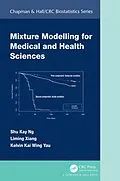Mixture Modelling for Medical and Health Sciences provides a direct connection between theoretical developments in mixture modelling and their applications in real world problems. The book describes the development of the most important concepts through comprehensive analyses of real and practical examples taken from real-life research problems in
Autorentext
Dr Angus Ng is a Professor of Biostatistics in the School of Medicine, Griffith University. He was awarded his PhD degree in statistics from the University of Queensland in 1999. Dr Ng is an experienced researcher, with expertise in the fields of biostatistics, statistical modelling, cluster analysis, pattern recognition, machine learning, image analysis, and survival analysis. In these areas, he has more than 100 publications. The focus in the field of statistical modelling has been on the theory and applications of finite mixture models and on estimation via the EM algorithm. In his pioneering work on mixture model-based clustering of longitudinal data, he has elucidated a clear vision for the role of random-effects models to provide a sound theoretical framework for classifying correlated longitudinal data and exploring possible relationships among groups of correlated subjects.
Dr Ng was awarded six ARC grants and has been actively involved in multidisciplinary research projects, NHMRC research projects, as well as consultancy and Government contracts. He is also a researcher with the Centre for Applied Health Economics (CAHE) and is an Associate Editor of the Journal of Statistical Computation and Simulation.
Prof. Kelvin K W Yau is a professor in the department of management sciences at the City University of Hong Kong. His research interests include Generalized Linear Mixed Models, Multivariate Survival Analysis, Finite Mixture Models, Robust Estimation, Statistical Modelling and Zero-Inflated-Poisson Models.
Liming Xiang is a professor of statistics at Nanyang Technological University in Singapore. She got her PhD degree in 2002 from the City University of Hong Kong. She serves as associate editor for Statistics in Medicine, Computational Statistics & Data Analysis and Journal of Statistical Computation and Simulation.
Inhalt
- Introduction
- Mixture of Normal Distributions for Continuous Data
- Mixture of Gamma Distributions for Continuous Nonnormal Data
- Mixture of Generalized Linear Models for Count or Categorical Data
- Mixture Models for Survival Data
- Advanced mixture modelling with random-effects components
- Advanced Mixture Models for Multilevel or Repeated-measured Data
- Advanced Mixture Models for Correlated Multivariate Continuous Data
- Miscellaneous: Handling of Missing Data
Why Mixture Modelling is Needed
Example: UCLA Example Data Set
Fundamental Concepts of Finite Mixture Models
Maximum Likelihood Estimation
Spurious Clusters
Determination of the Number of Components
Identifiability of Mixture Distributions
EM Algorithm
Basic Principles of the EM Algorithm
Formulation of Mixture Modelling as Incomplete-Data Problems
Convergence and Initialization of the EM Algorithm
Provision of Standard Errors of Estimates
Applications of Mixture Models in Medical and Health Sciences
Overview of Book
Sample Size Considerations for Mixture Models
Computing Packages for Mixture Models
R Programs
Fortran Programs
Introduction
E- and M-steps
Diagnostic Procedures
Example: Univariate Normal Mixtures
Example: Multivariate Normal Mixtures
Extensions of the Normal Mixture Model
R Programs for Fitting Mixtures of Normal Distributions
Introduction
E- and M-steps
Diagnostic Procedures
Example: Mixture of Gamma Regression Model
Example: Mixture of Gamma Distributions for Clustering Cost Data
Fortran Programs for Fitting Mixtures of Gamma Distributions
Introduction
Poisson Mixture Regression Model
Zero-inflated Poisson Regression Model
Zero-inflated Negative Binomial Regression Models
Example: Pancreas Disorder Length of Stay Data
Score Tests for Zero-inflation in Count Models
Example: Revisit of the Pancreas Disorder LOS Data
Mixture of Generalized Bernoulli Distributions
E- and M-steps
Cluster Analysis in Comorbidity Research
Example: Australian National Health Survey Data
Computing Programs for Fitting Mixture of Generalized Linear Models
Introduction
Application of Mixture Models in Survival Analysis
Mixture Models of Parametric Survival Distributions
The EM Algorithm for Mixtures of Parametric Survival Models
Example: Survival mixture modelling of mortality data
Semi-Parametric Mixture Survival Models
The ECM Algorithm
Example: Survival analysis of competing-risks data
Long-Term Survivor Mixture Models
Example: Long-term survivors mixture model
Diagnostic Procedures
Fortran Programs for Fitting Mixtures of Survival Models
Why is random effects modelling needed?
Fundamentals for GLMM formulation and derivation
Normally distributed random components and BLUP estimation
Maximum likelihood (ML) estimation
Residual maximum likelihood (REML) estimation
Generalized linear mixed models (GLMM)
Application of GLMM to mixture models with random effects
Poisson mixture models
Zero-inflated Poisson mixture models
Frailty models in survival analysis
Survival mixture models
Long-term survivor models with random effects
Introduction
Poisson Mixture Regression Model with Random Effects
Robust Estimation Using Minimum Hellinger Distance
Assessment of Model Adequacy and Influence Diagnostics
Example: Recurrent Urinary Tract Infection Data
Zero-inflated Poisson Mixture Models with Random Effects
Score test for zero-inflation in mixed Poisson models
Example: Revisit of the Recurrent UTI Data
Survival Mixture Models with Random Effects
Example: rhDNase Clinical Trial Data
Long-Term Survivor Mixture Models with Random Effects
Example: Chronic Granulomatous Disease (CGD) Data
Computing Programs for Fitting Multilevel Mixture Models
Introduction
Maximum likelihood estimation via the EM algorithm
Clustering of gene-expression data (cross-sectional with repeated measurements)
Inference on differences between classes using cluster specific contrasts of mixed effects
A non-parametric clustering approach for identification of correlated differentially-expressed genes
Example: Cluster analysis of a pancreatic cancer gene expression data set
Clustering of time-course gene-expression data
Inference for gene regulatory interactions
Example: Cluster analysis of a time-course gene expression data set
Clustering of multilevel longitudinal data
EM-based estimation via maximum likelihood
Example: Cluster analysis of a multilevel longitudinal data set
R and Fortran Programs for Fitting Mixtures of Linear Mixed Models
Introduction
Mixture model-based clustering of data with missing values
Multiple imputation approach
EM Algorithm
Example: Multivariate nor…
